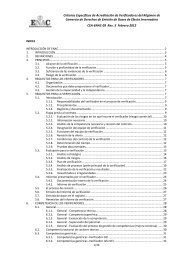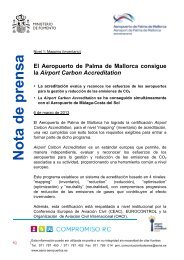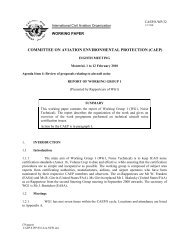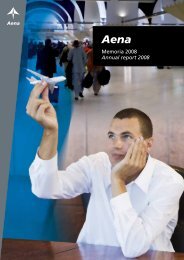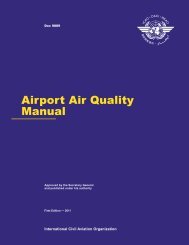Aircraft Maintenance Repair and Overhaul Market Study. - OBSA
Aircraft Maintenance Repair and Overhaul Market Study. - OBSA
Aircraft Maintenance Repair and Overhaul Market Study. - OBSA
- No tags were found...
You also want an ePaper? Increase the reach of your titles
YUMPU automatically turns print PDFs into web optimized ePapers that Google loves.
1. Air Transport Industry Forecast1.1 Forecast of World Fleet 2005-2035MSP Solutions has prepared its own economic <strong>and</strong>aircraft fleet forecasts. This estimates the numberof aircraft by category until 2035. The forecast wasdeveloped using three steps:• First a macro economic forecast was developedusing “mainstream” assumptions to assess GDPgrowth.• Traffic forecasts were then calculated from themacro economic forecasts using income <strong>and</strong> priceelasticity factors.• Finally an aircraft requirement was calculated,using assumptions on operati ng efficiencies <strong>and</strong>estimates of fleet composition by category.The forecast examines fleet numbers worldwide <strong>and</strong>for European based aircraft. Passenger <strong>and</strong> cargotypes have been calculated separately.The fleet categories used are as follows:• 747 or larger – <strong>Aircraft</strong> over 400 seats. A380 willbe in this group.• Mid size wide body aircraft – Includes A300,A330, A340, A350, B767, B777, B787• Narrow bodies – <strong>Aircraft</strong> over 90 seats: B757 <strong>and</strong>A320, B737 families• Regional jets – <strong>Aircraft</strong> below 90 seatsThe cargo aircraft are also classified in the samecategories.The results of the forecast were compared with theforecasts published by Airbus <strong>and</strong> Boeing forecasts.Additionally a sensitivity analysis was prepared usingmore cautious economic assumptions than those ofthe mainstream scenario. The results are shown inAppendices 4 <strong>and</strong> 5.Macro Economic ForecastMSP Solutions used the forecast prepared by theUS Department of Energy (DOE). Their figures producedsimilar GDP results as other forecasts suchas those of the IMF, but importantly they includedan estimate of oil prices, which is crucial to an airtransport forecast.The DOE forecast only looked as far as 2025, sothe ensuing 10-year figures were extrapolated. Themainstream forecast shows the global GDP growthslowing during the period from 4.0% to 3.5%, com-pared with an average of 4.3% for the period 2001-2005. European growth slows from 2.5% to 2.2%.Of the manufacturers, only Boeing showed the GDPforecast. They used an average growth rate of 2.9%,which seems fairly cautious.The DOE oil price forecast expects a 6.6% annualreduction in real terms until 2010, followed by anannual increase of 0.8%. This in effect makes theassumption that the oil price rises experienced during2005 were a short-term phenomenon. This issueis considered further in the sensitivity analysis.Traffic GrowthTraffic growth is in large part driven by GDP growths,with elasticity varying in economies at differentstages of their development. Price is also an importantfactor.Passenger traffic has grown at an average of 4.6%per annum since 1985, while European growth hasincreased at 5.7% per annum. The higher figure forEurope reflects the stimulation effect of low prices,especially a consequence of the rapid expansion oflow cost carriers. It should also be noted that theworldwide growth rate has proved remarkably consistentover the long term, with short-term falls, asoccurred in 2002, being quickly recovered within afew years.Forecasts for passenger growth are as follows.Airbus Boeing MSP SolutionsWorld Europe2005-2015 6.0% 5.3% 5.8% 4.1%2015-2025 4.6% 4.3% 4.7% 3.2%2025-2035 4.5% 3.0%The three forecasts are all in a remarkably similarrange, though it should be noted that the first period2005-2015 is above the long-term trend. This is notentirely surprising given that the fuel price assumptionmeans significant reductions in real terms,which would translate into lower prices <strong>and</strong> greatertraffic stimulation. Additionally the advent of lowcosts carriers has had the impact of forcing generalcost reductions throughout the industry.It is also assumed that airlines can continue to makeother unit cost efficiencies, for example through8STRAIR <strong>Aircraft</strong> <strong>Maintenance</strong> <strong>Repair</strong> <strong>and</strong> <strong>Overhaul</strong> <strong>Market</strong> <strong>Study</strong>. Glasgow International Airport.





